Menus
- Displacement and concept comparison – what is convincing on the country road?
- 600 cubic
- 600 cubic: technical data
- 1000 cubic
- 1000 cubic: technical data
- Which fits now?
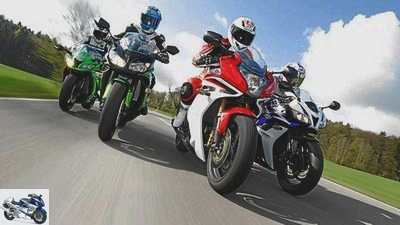
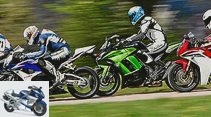

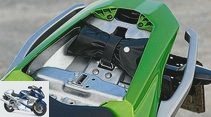
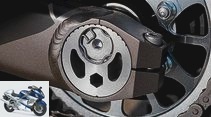
25th photos

1/25
Concept comparison: super athletes versus touring athletes from Honda and Kawasaki. In the test: Kawasaki Ninja ZX-10R, Kawasaki Z 1000 SX, Honda CBR 600 F and Honda CBR 600 RR.
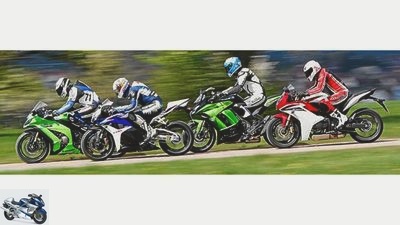
2/25
Kawaski Ninja ZX-10R, Honda CBR 600 RR, Kawasaki Z 1000 SX, Honda CBR 600 F.
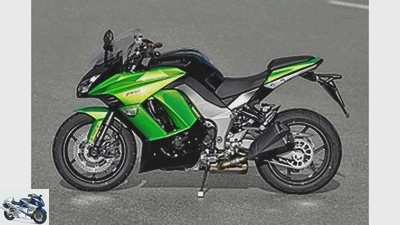
3/25
The Kawsaki Z 1000 SX.
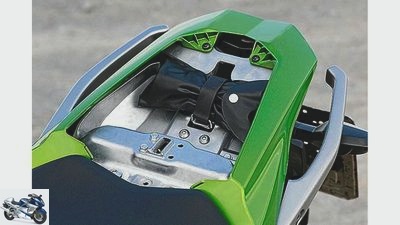
4/25
More space: The rear frame is also made of cast aluminum, but more expansive and with more storage space on the Z 1000 SX.

5/25
You rarely see that nowadays: nice eccentric for the rear axle mount for easy chain tensioning on the Kawasaki Z 1000 SX.
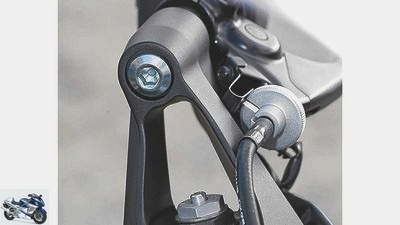
6/25
First the comfort: Curiously shaped handlebar halves allow you to sit upright, but make access to the fork adjustment elements on the Kawasaki Z 1000 SX difficult.
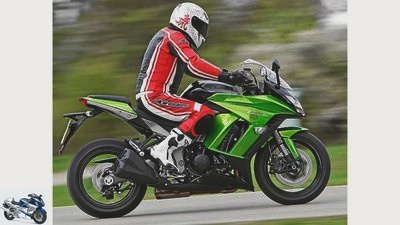
7/25
Even if the knee angle is not much more open than on the ZX-10R, the notches further forward and the higher handlebars ensure relaxed sitting on the SX.
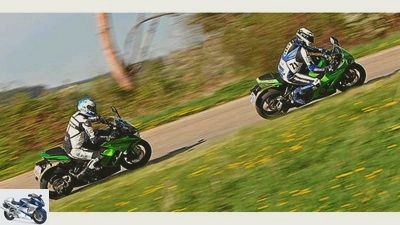
8/25
Kawasaki Z 1000 SX and Kawasaki Ninja ZX-10R.
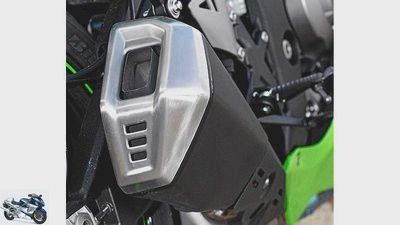
9/25
Central organ: stub exhaust and front silencer under the engine of the ZX-10R.
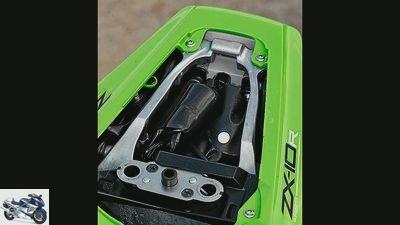
10/25
In a nutshell: The filigree frame rear made of cast aluminum is evidence of the fight for every gram in the Ninja.
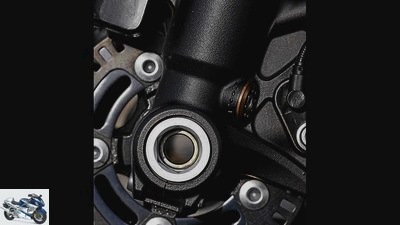
11/25
Lush: fat front axle, big piston fork with preload adjuster in the fork base of the Kawasaki Ninja ZX-10R.
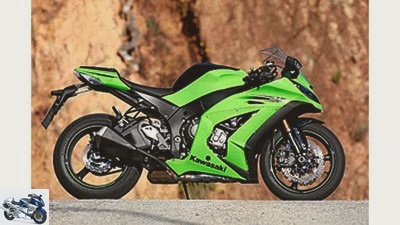
12/25
The Kawasaki Ninja ZX-10R.
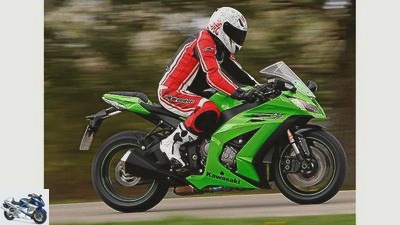
13/25
Having strong triceps isn’t a disadvantage. The torso is bent far forward and weighs heavily on the arms. Handlebar and seat almost at the same height on the Ninja ZX-10R.
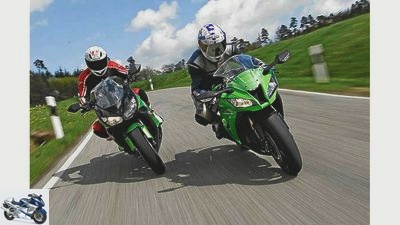
14/25
It is said that one can never have enough performance. But with the smoke that modern 1000s offer, doubts are allowed. The Kawasaki Z 1000 SX and the ZX-10R.
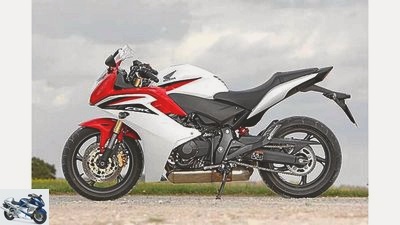
15/25
Honda CBR 600 F..
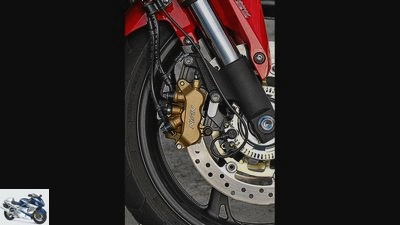
16/25
Imaginative cable routing on the tamely tuned floating caliper brake of the 600 F.
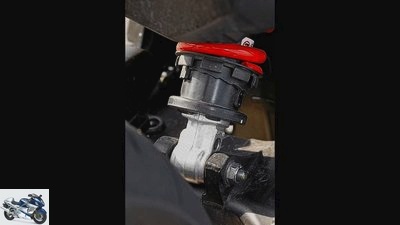
17/25
The shock absorber has to do without complex deflection, the spring preload is easily accessible on the Honda CBR 600 F..
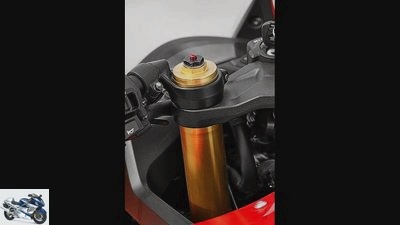
18/25
The tuning of the fork, which can only be adjusted in rebound and preload, was done somewhat carelessly on the touring athlete from Honda.

19/25
It looks a lot more relaxed than with the RR. The upper body is more upright, the wrists are relieved, the knee angle is slightly larger thanks to higher handlebars and deeper notches.
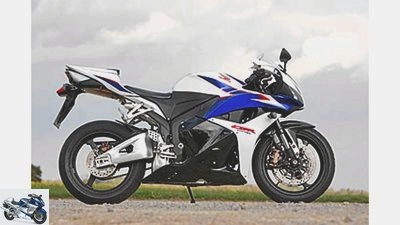
20/25
CBR 600 RR.
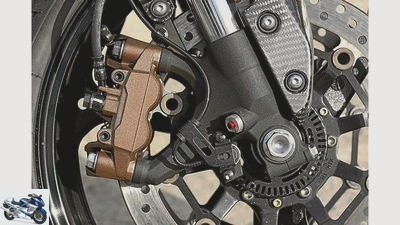
21/25
Also with ABS, but with solidly gripping four-piston radial pliers for finely adjustable braking power on the RR.
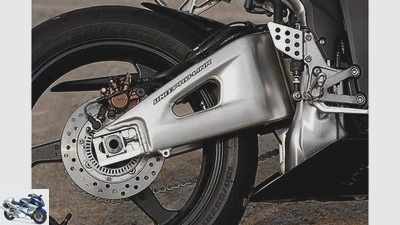
22/25
Torsion-resistant aluminum swingarm with powerful profiles and strut deflection, high sports standard at Honda.
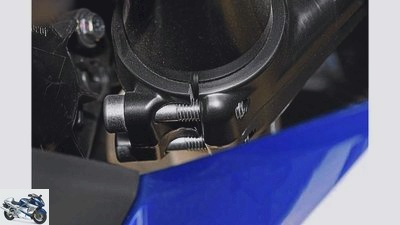
23/25
In contrast to the single screwed lower triple clamp of the F, that of the RR has a stable double clamp.
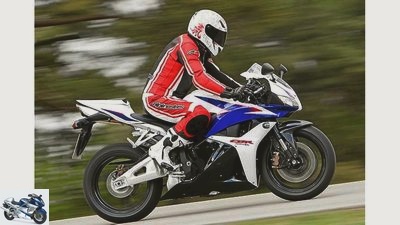
24/25
The handlebars close to the driver, the rests at a sporty height. Tall and long-legged people have to make themselves a little small on the RR.
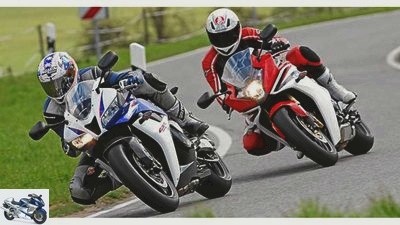
25/25
Honda CBR 600 RR and CBF 600 F.
Comparison test: athletes against touring athletes
Displacement and concept comparison – what is convincing on the country road?
When it comes to finding a suitable base for everyday sporting activities, you have to choose: high handlebars or stubby? It’s just a question of taste, or it’s worth thinking outside the box?
There are a few topics at the motorcycle round tables that regularly get people excited in heated discussions. How much performance a person needs in normal life, for example.
Obut who: whether sporty and ambitious natures are better dressed on the country road with a thoroughbred sports slicer or a somewhat more moderate sports tourer. Especially when they also have common technical roots. On the race track, where the dance takes place on the knife edge on a manageable slope clad with impeccable asphalt and calculable curve sequences, there is no question.
Buy complete article

Comparison test: athletes against touring athletes
Displacement and concept comparison – what is convincing on the country road?
The CBR 600 F and the CBR 600 RR represent the little rascals. Kawasaki ZX-10R and Z 1000 SX fight the duel in the one-liter class.
600 cubic
Honda CBR 600 RR and CBR 600 F.
They exist. In huge quantities. Dreamy, small streets, discreet and avoided by the tin caravans. Those who are crazy with endless curves, turn their heads and just wait to be conquered in the morning or on a little ride after work.
A small, agile 600 should be in its element here. With the CBR 600 RR and CBR 600 F, Honda has two alternatives. At first glance, the similarities between the two seem greater than the differences. But no sooner have the command centers boarded, hands on the handlebars, than you know where the wind is blowing from.
The F places her rider a lot lower on a wholesome padded bench, the handlebars at a relaxed distance and height. On the "RR" A tight, authentic, athletic-style sandwich is waiting for you. Your handlebar stubs require a much deeper bow and sit closer to the driver, who also has to fold his knees much more tightly. As you can see, this is how real sports comrades are folded. The F, on the other hand, exudes a feel-good aroma. But does that mean that it is only good for strolling? Well, at least she can stroll. Because the relaxed sitting position invites you to roll around with pleasure. The four-cylinder purrs gently, and the load changes in the apex of the curve are gentle on the throttle valve. Nothing is stressful or annoying, gliding can be so easy. There was applause from all three test pilots. The handling could be a bit crisper, but it is always light-footed. Ha, such a stroll, the RR does it with its left hand, right? Well, neither the chassis nor the brakes are really challenged this way. But you feel like a tiger in a cage. Sitting huddled like a catapult, waiting for someone to pull the trigger. But that doesn’t happen, because we’re relaxed on the road. And so you don’t really know what to do with the lively agility. Bjorn and Stefan, one of the beginners and the other not averse to brisk pace, feel that the RR’s willingness to change direction with every tiny steering impulse is more of a nervousness. And the author growls dissatisfied under his helmet because the potential of the racing CBR is not even rudimentarily implemented. But when the pace gets a little faster, the RR will show where the hammer is. Think. The F can really do a faster pace. Bjorn is beaming. "An incredibly accessible machine, the upright sitting position does the rest." And Stefan agrees: "Actually a very good motorcycle, you sit upright, but still active, very user-friendly – except for the badly readable display."
"But the RR is the much more precise machine, gives a lot more feeling and feedback", the racer grumbles. That’s right, the F looks doughy at a brisk pace, doesn’t provide as much feedback and doesn’t steer as agile and precisely. On the other hand, it is precisely because of this somewhat calmer trait that it exudes the serenity that inspires Bjorn and Stefan to drive the F through the tangle of curves quite naturally. In any case, the two of them are not on the go any slower than with the RR and still find it too strenuous and demanding. "Very handy and precise – if you aim correctly, that simply requires a lot of skill, ponders Bjorn. Those looking for racing spirit will appreciate exactly that.
But it also has to live with the noticeably harder load change reactions. The F can do that better – another piece of the mosaic for a relaxed drive. Okay, then on the very quick tour. And now the RR is in its element. Now everything fits, precise turning, arcs as if drawn with a scalpel, and the snappy brakes can also show their skills when dashing into the bends. Fantastic, the stability and the feedback from the road, the athlete’s heart blossoms. You can now literally feel that everything on this motorcycle – rigidity, mass distribution, center of gravity – is designed for this purpose.
The F needs to tear off at this point. With the comfortable spring elements, which can only be adjusted in rebound and preload, and the simple backbone frame with directly hinged shock absorber, it can’t hold a candle to the RR in terms of precision and stability. The brakes cannot offer a sporty bite, which is just as opposed to committed late braking as the defensive ABS. And when properly oned, the RR motor shows its strengths. The racer is happy. Bjorn and Stefan don’t contest that. You have taken the F to your heart.
600 cubic: technical data
archive
From 11,000 rpm, the matter is clear: From this mark, the CBR 600 RR begins to fly high. It turns almost 3000 rpm further than the F and draws its superior peak performance from it. But even under it, it does not do so badly. The engine of the CBR 600 F, which is somewhat braked in performance and which, by the way, was originally cradled in the current generation RR engine, draws a little more torque from low speeds, which is particularly interesting for those who like to drive at low revs.
Honda CBR 600 RR
| engine | design type | Four-cylinder, four-stroke in-line engine |
| Bore x stroke | 67.0 x 42.5 mm | Displacement | 599 cm3 |
| power | 88.1 kW (120 PS) at 13500 rpm | Torque | 66 Nm at 11250 rpm | landing gear | frame | Bridge frame made of aluminum |
| Brakes v / h | Ø 310 mm / Ø 220 mm | tires | 120/70 ZR 17; 180/55 ZR 17 | mass and weight | wheelbase | 1375 mm |
| Steering head angle | 66.5 degrees | trailing | 98 mm |
| Seat height ** | 820 mm | Weight with full tank ** | 188 kg |
| Price (without additional costs) | 12,960 euros | MOTORCYCLE readings |
| Top speed * | 265 km / h | acceleration |
| 0-100 km / h | 3.2 sec | 0-140 km / h | 5.2 sec |
| 0-200 km / h | 9.9 sec | Draft |
| 60-100 km / h | 4.7 sec | 100-140 km / h | 4.8 sec |
| 140-180 km / h | 4.5 sec | consumption |
| Country road | 4.6 liters / normal |
Honda CBR 600 F.
| engine | design type | Four-cylinder, four-stroke in-line engine |
| Bore x stroke | 67.0 x 42.5 mm | Displacement | 599 cm3 |
| power | 75.0 kW (102 hp) at 12,000 rpm | Torque | 64 Nm at 10500 rpm | landing gear | frame | Backbone frame made of aluminum, supporting the engine |
| Brakes v / h | Ø 296 mm / Ø 240 mm | tires | 120/70 ZR 17; 180/55 ZR 17 | mass and weight | wheelbase | 1437 mm |
| Steering head angle | 65.0 degrees | trailing | 99 mm |
| Seat height ** | 790 mm | Weight with full tank ** | 214 kg |
| Price (without additional costs) | 9160 euros | MOTORCYCLE readings |
| Top speed * | 230 km / h | acceleration |
| 0-100 km / h | 3.6 sec | 0-140 km / h | 6.0 sec |
| 0-200 km / h | 14.2 sec | Draft |
| 60-100 km / h | 5.0 sec | 100-140 km / h | 5.5 sec |
| 140-180 km / h | 6.2 sec | consumption |
| Country road | 4.5 liters / normal |
* Manufacturer information; ** MOTORCYCLE measurement
1000 cubic
It is said that one can never have enough performance. But with the smoke that modern 1000s offer, doubts are allowed. The Kawasaki Z 1000 SX and the ZX-10R.
Actually, the thing is already decided before the first crankshaft turns. On the one hand, 197 hp meet 203 kilograms. On the other hand, 135 hp have to cope with 231 kilograms. Any questions? Why, surely. For example: What are such number games worth in the wild?
Stefan, Bjorn and the author are in the starting blocks to take the winding streets under the wheels. First of all with braked foam, on the very relaxed tour.
Ah, what a relief. Stefan breathes a sigh of relief. In contrast to the weak-chested 600s, the ZX-10R pushes easily in the lower third of the speed. You can live with that. And because the ZX-10R does not plunge into corners as easily as the CBR 600 RR, maximum concentration is not always required when turning in order not to make an unintentional jagged turn due to a slightly excessive steering impulse. Only the seating position is more extreme due to the lower handlebar stub. Even when the adjustable notches are fixed in the comfortable low position. There is a lot of weight on the wrists, not exactly relaxed, and certainly not downhill in tight bends, where the handling becomes tough. And in contrast to the wrists, the engine and chassis are not challenged at all.
The Z 1000 SX delivers a different picture. Hardly in motion, she seems to shed 20 kilograms. "The upright sitting position provides an overview", is pleased Stefan. "Exactly, and with the wide handlebars it’s easy to direct", Bjorn beams.
Clearly the better choice for this gait. And what if the curves are faster? Then the ZX-10R feels much more comfortable. Was to be expected. The aggressive sitting position starts to make more sense, even if, spurred on by the constant push-ups, you actually want to give the spurs to the still underemployed motor and pull the cable properly.
On the Z 1000 SX you can see that in a relaxed manner. Because the SX is ideally equipped for rapid speed. And the tens remains lively on the heels. The chassis offers enough cushioning reserves so that you don’t stumble. Unlike the Honda CBR 600 F, the shock absorber has a deflection, the stable aluminum swing arm has a nice eccentric mount on the rear wheel. And the front wheel rotates around a powerfully dimensioned axle and sits in a fully adjustable fork.
Even if the knee angle is not much more open than on the ZX-10R, the notches further forward and the higher handlebars ensure relaxed sitting on the SX.
But that’s not all. What was already apparent during the moderate gliding, now really comes into play: The SX swings a completely different hammer than the ZX-10R. Or to put it another way: exit a curve, 60-70 km / h, second gear, the SX, which is translated for short, pushes its rider out of the corner with around 75 hp. While the ZX-10R, powered by 50 HP, is rather slow to pick up speed. The punch with which the SX reaches the lower third of the speed brings the dynamism that you need on the country road and that makes you relaxed and fast. A look at the traction diagrams speaks volumes. Especially since the SX also accelerates spontaneously, willingly and gently and directly. Top notch. "With the ZX-10R, the music only starts to play properly from the middle speed range. Associated with a serious disadvantage. One photo in this speed range – regardless of the gear – and you are a pedestrian for a long time", Stefan sees the matter with mixed feelings. Okay, but when it comes down to it, when the pace is really tightened, the ten will pull the skin over its ears, bet? Attention. Because if you give it the spurs, the SX can also hiss really angry around the corner.
Their brakes are hardly inferior to those of thoroughbred sports machines, they pack really hard and can also be finely dosed. The engine pushes forward uniquely, works its way linearly through the speed range and can even increase in the highest positions.
And the chassis still plays along quite well, especially since the pilot peppers the SX on the wide handlebars from one lean angle to the next. These trump cards stand out. But in the end the ten driver has the better cards. Especially the wider and faster the arches get. On the one hand, the SX rises more strongly when braking. On the other hand, their higher weight and higher center of gravity have an impact on heating, which is why their steering precision and the speed with which lean angles can be changed do not reach the level of the athlete.
In the end, the ZX-10R simply sticks right into the corners and is easier to keep on the targeted course. Even though you still miss the very last ounce of accuracy. Which may be because it rolls on BT-016 rubbers while the top test specimen was still soled with Pirelli Diablo Corsa III.
Nevertheless, where the SX is already cutting its footpegs on the asphalt, the Zehner is still leaning on the lean. And it simply delivers that level of stability and feedback that the racer loves and needs. In addition, the seating position now fits perfectly at this speed, while the one on the SX turns out to be a bit too passive for the seriously sporty pace. Only: with a halfway life-affirming driving style, exploring the true potential of the ZX-10 reactor, which only really bites from 9000 rpm, is out of the question. At best on the motorway – or on the racetrack. The SX drive, on the other hand, can be squeezed out sooner, which is much more likely to create a certain satisfaction than just tickling a high-performance engine and squeezing it sporadically at most.
Nevertheless, the world is all right again for our sports driver. He knows what potential lies dormant in his projectile, he enjoys his precision tool when swinging corners. While the SX pilots head home with the certainty that they will ultimately let the ZX-10R go, but otherwise only have to do very little.
1000 cubic: technical data
archive
At first glance, two worlds open up: The engine of the ZX-10R simply seems to crush that of the Z 1000 SX. But in the vast majority of cases, real life takes place with up to six, a maximum of eight thousand revolutions. And here the SX is way ahead. The speed range in which the ZX-10R unpacks its hammer is rarely visited, which is why the Zehner can hardly show its performance superiority on the country road.
Kawasaki Ninja ZX-10R
| engine | design type | Four-cylinder, four-stroke in-line engine |
| Bore x stroke | 76.0 x 55.0 mm | Displacement | 998 cm3 |
| power | 147.0 kW (200 hp) at 13,000 rpm | Torque | 112 Nm at 11500 rpm | landing gear | frame | Bridge frame made of aluminum |
| Brakes v / h | Ø 310 mm / Ø 220 mm | tires | 120/70 ZR 17; 190/55 ZR 17 | mass and weight | wheelbase | 1425 mm |
| Steering head angle | 65.0 degrees | trailing | 107 mm |
| Seat height ** | 813 mm | Weight with full tank ** | 203 kg |
| Price (without additional costs) | 16,665 euros | MOTORCYCLE readings |
| Top speed * | 295 km / h | acceleration |
| 0-100 km / h | 3.0 sec | 0-140 km / h | 4.5 sec |
| 0-200 km / h | 7.2 sec | Draft |
| 60-100 km / h | 3.7 sec | 100-140 km / h | 3.3 sec |
| 140-180 km / h | 3.4 sec | consumption |
| Country road | 5.4 liters / super |
Kawasaki Z 1000 SX
| engine | design type | Four-cylinder, four-stroke in-line engine |
| Bore x stroke | 77.0 x 56.0 mm | Displacement | 1043 cm3 |
| power | 101.5 kW (138 hp) at 9600 rpm | Torque | 110 Nm at 7800 rpm | landing gear | frame | Backbone frame made of aluminum, supporting the engine |
| Brakes v / h | Ø 300 mm / Ø 250 mm | tires | 120/70 ZR 17; 190/50 ZR 17 | mass and weight | wheelbase |
1440 mm
* Manufacturer information; ** MOTORCYCLE measurement
Which fits now?
Kawaski Ninja ZX-10R, Honda CBR 600 RR, Kawasaki Z 1000 SX, Honda CBR 600 F.
So, are the clip-on handlebar-reinforced heating irons really unrivaled in everyday life and in a class of their own? Let’s put it this way: Those who do not attach importance to constantly giving their Kneepads the finishing touch will find the sports tourers extremely pleasant and thoroughly blessed with athletic talents. In the case of the Kawasaki Z 1000 SX even with considerable talents.
With the 600s, the gap in everyday life is not that great in terms of engine technology, the gap only opens when glowing at the highest revs.
The main difference is the chassis. The racer who derives his driving pleasure and the basis for lustful cornering mainly from a first-class chassis will find the right playmate in the CBR 600 RR. Which, however, also requires a certain level of skill. The other two drivers find it rather exhausting. The good-natured F comes much closer to you.
In the case of the Kawasaki, things are a little different. Sure, the SX is the hardest. But their chassis is of high quality enough to look good even with decisive gasping. Your four-cylinder has the pressure in the right place, and enjoy groovy cornering fun upright and relaxed, that’s something. Especially since this combination is almost equal to the superbike in everyday life. Even avowed sports fans could start pondering.
Only those who can do without the compulsory start of the SX downstairs, prefer to actively exercise in the saddle along the limit, are looking for that inimitable racing feeling that only real athletes can offer, and who accept the stooped posture for that little bit more handiness, the ZX-10R fits perfectly. Only: Calling up your true performance potential, even the racer will probably not be able to do that on public roads. This experience is more likely to be made possible by the SX. So it is not the demanding sports file, but, as with the Hondas with the Z 1000 SX, the moderate concept that gives normal and sporty drivers the greatest pleasure.
Related articles
-
Comparison test sports tourer Kawasaki Z 1000 SX Tourer, Triumph Sprint GT
www. 35 pictures www. 1/35 Sports tourers sit between all chairs, but the temptation lies in this niche: there are bikes, …
-
Aprilia Tuono V4 1100 RR, Kawasaki Ninja H2 and BMW S 1000 XR in the comparison test
Arturo Rivas Gonzalez 31 photos Arturo Rivas Gonzalez 1/31 Aprilia Tuono V4 1100 RR, Kawasaki Ninja H2 and BMW S 1000 XR. Arturo Rivas Gonzalez 2/31 And…
-
Kawasaki ZX-10R and BMW S 1000 RR in a comparison test
www.bilski-fotografie.de 25th photos www.bilski-fotografie.de 1/25 First, let’s take a look at the new Kawasaki ZX-10R. www.bilski-fotografie.de 2/25 In…
-
Suzuki GSX-R 750 – GSX-R 1000 in comparison test
Rivas Family duel: Suzuki GSX-R 750 / GSX-R 1000 The super athletes from Suzuki in comparison test The GSX-R sisters are visually difficult to…
-
Eight large touring motorcycles in a comparison test
Photo: 24 photos 1/24 BMW R 1200 GS Rallye, Moto Guzzi Stelvio 1200 8V, Triumph Tiger Explorer, KTM 990 Adventure, Kawasaki…
-
Comparison test of the 1000 super sports car
Jaime de Diego 38 photos fact 1/38 Yamaha charges 14,895 euros for their completely new R1 super sports bike. fact 2/38 Even without ABS, the Fireblade…
-
Comparison test: 125cc supermotos
20th photos 1/20 Successful appearance: With all five supermotos you can be seen anywhere without hesitation. 2/20…
-
Comparison test of 450 cc motocrosss
Motociclismo Comparison test 450 cc motocross 2011 Crossers from Honda, Kawasaki, KTM, Suzuki and Yamaha Ironically, in the top motocross class (MX1, 450…
-
Comparison test: 34 hp motorcycles
29 photos 1/29 Last but not least, the only thing missing is the Suzuki Bandit 1250. It is worth buying, especially if you want…
-
Comparison test: 250cc motocross
Motociclismo Comparison test: 250 cc motocross 2011 The revised 250 cc Crosser in comparison If you don’t want to be sandblasted by your colleagues in…